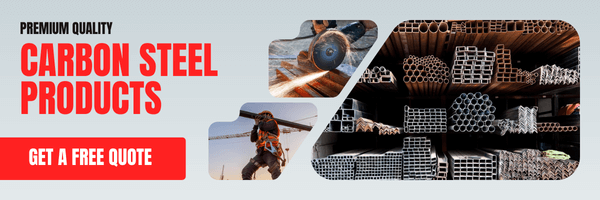ASTM Standards: What it Stands For, How To Read Them, & More
March 27, 2024 | Categorized in: Properties

If you’ve worked in the steel industry or purchased steel, you’ve probably seen ASTM designations before. For example, we commonly use ASTM A36 steel, a low-carbon alloy, in products like our plates and coils. But what is ASTM and what does A36 actually mean?
What does ASTM stand for & what is it?
ASTM International, or the American Society for Testing and Materials, is a globally recognized organization of material producers, users, and other scientific-focused parties involved in the manufacturing and applications of materials. They develop standards for a wide variety of testing, classifications, practices, and more to inform and supplement regulations and laws around the world. Through this, ASTM is at the forefront of ensuring the safety, quality, and consistency of material production and usage.
What do ASTM standards cover?
Saying that ASTM standards apply to “materials” is very broad, but that’s because they really do apply to a huge number of industries and products. From paints and petroleum to textiles, plastics, and metals, ASTM has over 12,000 standards that can apply to thousands of different goods or substances.
ASTM vs. ASME
Another common designation acronym that you may be familiar with is ASME. This is the American Society of Mechanical Engineers, which develops codes and standards for mechanical engineering safety and applications. Both ASME and ASTM work together to create specifications where their areas of expertise overlap, and ASME often uses certain ASTM-certified materials in their ASME-approved processes and equipment. However, there are still many ASTM standards that don’t meet ASME criteria for certain applications.
What are the types of standards that ASTM develops?
ASTM standards are broken into six categories that span the manufacturing process, as well as conceptualization and terminology:
- ASTM Specification Standards: Conditions and provisions for products, materials, systems, or services to meet. Based on these conditions, it will be determined whether certain test methods are appropriate.
- ASTM Test Method Standards: Specifications for procedures that determine a property or constituent of a product, material, or collection of materials. Often includes details about testing apparatus, specimens, process steps, and data calculations.
- ASTM Classification Standards: Requirements for assigning products, materials, systems, and services into categories or groups. The requirements are based on factors such as composition, properties, origin, and more.
- ASTM Practice Standards: Specific instructions for the performance of a task or operation. Often includes a checklist and series of steps to safely and effectively accomplish said task.
- ASTM Guide Standards: Typically details several choices for the user to pick from rather than a single answer. For instance, a set of procedures to accomplish a given goal but the selected method depends on the individual situation or needs.
ASTM Terminology Standards: Covers terms, acronyms, abbreviations, and symbols that are used in a given industry. Defining each reduces confusion around materials or chemicals that have multiple names.
How to read ASTM designations
ASTM codes consist of a letter followed by a sequentially assigned number. The letters refer to different categories of products, materials, or processes:
- A: Ferrous metals and products (like steel)
- B: Nonferrous metals and products
- C: Cementitious, ceramic, concrete, and masonry materials
- D: Miscellaneous materials
- E: Miscellaneous subjects
- F: End-use materials and products
- G: Corrosion, deterioration, weathering, and degradation of materials and products
- H: Joint committee and district recipients
The number that comes after the prefix letter is arbitrary and just identifies the exact code or standard within the category specified by the prefix.
Common ASTM steel grades
Looking specifically at steel, ASTM standards are typically used to differentiate the steel grade and chemical composition of the material, as well as testing and finishing services. An example of ASTM designations for finishing services would be hot-dip galvanizing steel, which has three ASTM codes that govern the process and guidelines: A123, A153, and A767.
ASTM A36
A36 is the most common mild and hot rolled steel specification due to its weldability and ease of use in machining, drilling, punching, grinding, etc. ASTM A36 steel has tight tolerances around properties like its density (7,800 kg/m³), Poisson’s ratio (0.32), and ultimate tensile strength (58,000-80,000 psi). All of this paired with an affordable price point makes A36 incredibly adaptable and appealing for many projects.
ASTM A1011
This ASTM specification applies to hot rolled steel sheets and coils, and is one of the grade options we sell for these products. A1011 can withstand harsh weather and outdoor conditions, which makes it a good choice for various agricultural equipment and applications.
ASTM A6
A6 is a set of general requirements for dimensional tolerances, mill conditioning, etc. that applies to a range of rolled steel shapes from bars to plates to piling. We use ASTM A6 designation to cover all structural materials, including C and MC channels).
ASTM A572
This is a common high-strength, low-alloy steel specification with five different grades for structural steel shapes, sheet piling, bars, and plates. We stock steel plates and sheet coils in this specification because of its weldability and corrosion resistance.
Get high-quality, reliable steel today
Service Steel has built a reputation on premium quality and exceptional service. We always ensure you get steel that you can trust and ASTM grades that match your project needs. Our massive ready-to-ship inventory of high-quality steel is ready for your order, so call our team or request a quote today.

